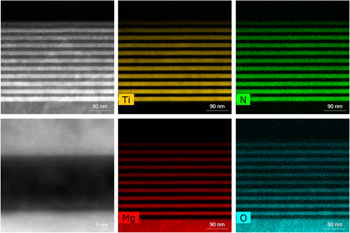Article contents
Two-dimensional Frank–van-der-Merwe growth of functional oxide and nitride thin film superlattices by pulsed laser deposition
Published online by Cambridge University Press: 13 July 2017
Abstract

Pulsed laser deposition is one of the most flexible growth methods for high-quality epitaxial multifunctional thin films and short-period superlattices. The following examples of current research interest demonstrate the state-of-the art: First, it is shown that the magnetoelectric performance of multiferroic BiFeO3–BaTiO3 (001)-oriented superlattices depends on the crystalline coherence of the different layers at the interfaces. Second, it is exemplified that dielectric-plasmonic superlattices built from the electrically insulating oxide MgO and the metallically conducting nitride TiN are promising metamaterials with hyperbolic dispersion. As a third example, it is demonstrated that LaNiO3- and LaMnO3-based superlattices with (001)-, (011)-, and (111)-out-of-plane orientation and controlled single layer thickness from 2 to 15 atomic monolayers show metal-insulator transitions and tunable gaps, in partial agreement with density functional theory calculations. Underlined by these examples, it is shown that the precise control of an epitaxially coherent, or two-dimensional layer-by-layer growth, named after Jan van der Merwe, is a prerequisite to achieve the desired functionality of oxide–oxide and oxide–nitride superlattices.
- Type
- Invited Review
- Information
- Journal of Materials Research , Volume 32 , Issue 21: Focus Issue: Jan van der Merwe: Epitaxy and the Computer Age , 14 November 2017 , pp. 3936 - 3946
- Copyright
- Copyright © Materials Research Society 2017
Footnotes
Contributing Editor: Mmantsae Diale
This section of Journal of Materials Research is reserved for papers that are reviews of literature in a given area.
References
REFERENCES
- 11
- Cited by



